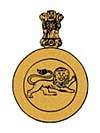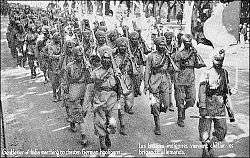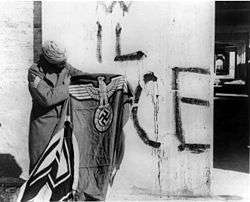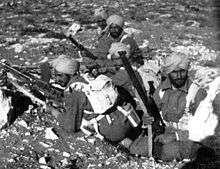Sikh Regiment
| Sikh Regiment | |
|---|---|
 Cap badge of the Sikh Regiment | |
| Active | 1 August 1846–Present |
| Country |
|
| Branch |
|
| Type | Line Infantry |
| Role | Infantry |
| Size | 19 battalions |
| Motto(s) | Nischay Kar Apni Jeet Karon (With determination, I will be triumphant). |
| War Cry | Bole So Nihal, Sat Sri Akal (one will be blessed eternally who says that God is the ultimate) |
| Anniversaries | September 12 |
| Decorations |
|
| Commanders | |
| Colonel of the Regiment | Lt. Gen. Sanjay Kumar Jha[2] |
| Insignia | |
| Regimental Insignia | Lion, symbolic of the name (Singh) every Sikh carries, ringed by a chakra |
_Sikh_Regiment_in_China%2C_Circa_1860..jpg)
The Sikh Regiment is an infantry regiment of the Indian Army that recruits from the Sikh community. It is the most highly decorated regiment of the Indian Army and in 1979, the 1st battalion was the Commonwealth's most decorated battalion with 245 pre-independence and 82 post-independence gallantry awards, when it was transformed into the 4th battalion, Mechanised Infantry Regiment.[3][4][5] The first battalion of the regiment was officially raised just before the annexation of the Sikh Empire on August 1 1846, by the British East India Company. Currently, the Sikh Regimental Centre is located in Ramgarh Cantonment, Jharkhand. The Centre was earlier located in Meerut, Uttar Pradesh.
The modern Sikh Regiment traces its roots directly from the 11th Sikh Regiment of the British Indian Army. When transferred to the Indian Army like its sister regiments, the numeral prefix (in the case of the Sikh Regiment, 11) was removed and extra battalions were raised, transferred or disbanded to meet army needs. With a humble beginning of two battalions, today the fraternity has grown to a regiment of 19 regular infantry and two reserve battalions strong.
Recruitment
Enlisted soldiers are strictly recruited from the Sikh community from Punjab and the surrounding states. They trained internally by the regiment, in which they tend to spend most of their careers. Officers, however, can come from all regions and communities in India and tend to leave the regiment subject to promotion. The war cry of regiment, taken from Sikh scriptures, is Jo Bole So Nihal, Sat Sri Akal. [lower-alpha 1]
In a departure from the single class composition, the 13th battalion was raised with multiple class composition: a company each of Sikhs, Dogras, Garhwalis and South Indians. However these units were reverted to their original class composition later.
Units
- 2nd Battalion
- 3rd Battalion
- 4th Battalion
- 5th Battalion
- 6th Battalion
- 7th Battalion
- 8th Battalion
- 10th Battalion
- 11th Battalion
- 13th Battalion
- 14th Battalion
- 16th Battalion
- 17th Battalion
- 18th Battalion
- 19th Battalion
- 20th Battalion
- 21st Battalion
- 22nd Battalion
- 23rd Battalion
- 24th battalion
- 124 Infantry Battalion Territorial Army (Sikh)
- 152 Infantry Battalion Territorial Army (Sikh)
- 167 Infantry Battalion Territorial Army (Sikh) (Home and Hearth)
Others:
- 1st Battalion is now 4th Battalion, Mechanised Infantry Regiment
- 9th Battalion was disbanded in 1984 due to mutiny
Awards and citations
The Museum of the Regimental Centre displays a record of the Sikh Regiment in four halls viz.,
- The Religious/motivational Hall,
- The Hall of Heritage,
- The Regimental Glory Hall
- The Peripheral Gallery.
With regards to the Kargil War, the Chief of Army Staff (COAS) made a special instant award of "Unit Citation" to the 8th battalion for their meritorious and gallant performance in the isolation of Tiger Hill, which facilitated the capture of Tiger Hill top and Helmet and India Gate, features to the West of Tiger Hill top, on night 07/8 July 1999, in Dras.
In all, the regiment has to its credit 1652 gallantry awards and honours including:
- 2 Param Vir Chakras
- 14 Maha Vir Chakras
- 68 Vir Chakras
- 2 Ashoka Chakras
- 14 Victoria Crosses
- 21 Indian Order of Merits
In addition it has also earned:
- 73 battle honours
- 38 theatre honours besides five COAS Unit Citations, including
- the one bestowed upon 8 Sikh during the 1999 Kargil episode
- and two "Bravest of the Brave" citations.
Battle honours and theatre honours
Battle honours
- Pre-Independence
- Lucknow 1857-58, 1 Sikh
- Defence of Arrah 1857, 3 Sikh
- Bihar 1857, 3 Sikh
- China 1860-62, 2 Sikh
- Ali Masjid 1878, 1 & 3 Sikh
- Ahmed Khel 1880, 2 Sikh
- Afghanistan 1878-79, 1 Sikh
- Afghanistan 1878-80, 2 & 3 Sikh
- Kandahar 1880, 2 Sikh
- Saukin Wind 1885, 2 Sikh
- Battle of Tofrek 1885, 2 Sikh
- Manipur 1891, 4 Sikh
- Defence of Chitral 1895, 1 & 2 Sikh
- Samana 1897, 4 Sikh
- Saragarhi/Gulistan 1897, 4 Sikh
- Punjab Frontier 1897, 2, 3, 4 & 35 Sikh (SRC)
- Malakand 1897, 3 & 35 Sikh (SRC)
- Tirah 1897-98, 2 & 4 Sikh
- China 1900, 1 Sikh
- North-West Frontier 1908, 3 Sikh
- World War I

- La Bassée 1914, 2 & 5 Sikh
- St-Julien 1914, 2 & 5 Sikh
- Armentières 1914-15, 5 Sikh
- Auber 1914, 2 & 5 Sikh
- Givens 1914, 4 Sikh
- Siege of Tsingtao 1914, 4 & 5 Sikh
- Neuve Chapelle 1914-15, 2, 3 & 5 Sikh
- France and Flanders 1914-15, 2 & 5 Sikh
- Suez Canal 1914-15, 1 Sikh
- Festubert 1915, 2 Sikh
- Tigris 1916, 3 & 5 Sikh
- Pyres 1915, 2 & 4 Sikh
- Sari Bair 1915, 1 Sikh
- Hells 1915, 1 Sikh
- Krishna 1915, 1 Sikh
- Suva 1915, 1 Sikh
- Gallipoli 1915, 1 Sikh
- Egypt 1915, 1 Sikh
- Mesopotamia 1916-18, 1, 3 & 4 Sikh
- Sharon 1918, 5 Sikh
- Palestine 1918, 5 Sikh
- Baghdad 1916-18, 5 Sikh
- Siege of Kut 1917, 1, 3 & 5 Sikh
- Hai 1917, 3 & 4 Sikh
- Megiddo 1918, 5 Sikh
- Persia 1918, 4 Sikh
- Egypt 1918, 2 & 3 Sikh
- Sharot 1918, 2 Sikh
- Inter-War years
- North West Frontier 1918-19, 5 & 35 Sikh (SRC)
- Afghanistan 1919, 2 & 35 Sikh (SRC)
- Palestine 1921, 5 & 35 Sikh (SRC)
- Second World War

- Agordat 1940-41, 4 Sikh
- Keren 1941, 4 Sikh
- El Alamein 1940-43, 4 Sikh
- Omars 1941, 4 Sikh
- Kuantan 1941-42, 5 Sikh
- Niyor Kluang 1941-42, 5 Sikh
- Mersa Matruh 1941-42, 2 Sikh
- Kota Bharu 1942, 5 Sikh
- North Arakan 1942-45, 1 Sikh
- Buthidaung 1942-45, 1 Sikh
- Coriano 1943-45, 2 Sikh
- San Mariano 1943-45, 2 Sikh
- Poggio San Giovanni 1943-45, 2 Sikh
- Monte Calvo 1943-45, 4 Sikh
- Kangla Tongbi 1944, 1 Sikh
- Gothic Line 1943-45, 4 Sikh
- Nyaungu Bridgehead 1945, 1 Sikh
- Irrawaddy River 1945, 1 Sikh
- Shandatgyi 1945, 1 Sikh
- Kama 1945, 1 Sikh
- Sittang 1945, 1 Sikh
- Post-Independence
- Srinagar 1947, 1 Sikh
- Tithwal 1948, 1 Sikh
- Raja Picquet 1965, 2 Sikh
- Burki 1965, 4 Sikh
- Op Hill 1965, 7 Sikh
- Siramani 1971, 4 Sikh
- Poonch 1971, 6 Sikh
- Purbat Ali 1971, 10 Sikh
- Tiger Hill 1999, 8 Sikh
Theatre honours
- Pre-Independence
- North Africa 1940-43, 2 & 4 Sikh
- Abyssinia 1940-41, 4 Sikh
- Iraq 1941, 3 Sikh
- North Africa 1941-42, 3 Sikh
- Malaya 1941-42, 5 Sikh
- Burma 1942-45, 1 Sikh
- Italy 1943-45, 2 & 4 Sikh
- Greece 1944-45, 2 Sikh
- Post-Independence
- Jammu & Kashmir 1947-48, 1, 5, 7 & 16 Sikh
- Jammu & Kashmir 1965, 2, 3 & 7 Sikh
- Punjab 1965, 4 Sikh
- Sindh 1971, 10 Sikh
- Punjab 1971, 2 Sikh
- East Pakistan 1971, 4 Sikh
- Jammu & Kashmir 1971, 5 & 6 Sikh
- Kargil 1999, 8 Sikh
Operation Blue Star
About 5000 Indian soldiers, some belonging to the regiment, mutinied after the storming of the Golden Temple by the Indian Army as part of Operation Blue Star in 1984. The Sikh Regiment's 9th battalion was disbanded after a large number of its troops mutinied.[6]
British Army Sikh Regiment
Advanced plans by the British Army to raise a Sikh infantry regiment that would recruit from the UK's Sikh community were scrapped due to accusations by the Commission for Racial Equality (CRE) that such a creation could be viewed as racist or sectarian. The plan had many supporters, including Prince Charles.[7]
Gallantry awards
- Indian Order of Merit
21 Sikh Regiment soldiers were posthumously awarded the Indian Order of Merit for their actions in the Battle of Saragarhi in 1897:[8][9]
- Hav. Ishar Singh
- Nk. Lal Singh
- L/Nk. Chanda Singh
- Sep. Sundar Singh
- Sep. Ram Singh
- Sep. Uttar Singh
- Sep. Sahib Singh
- Sep. Hira Singh
- Sep. Daya Singh
- Sep. Jivan Singh
- Sep. Bhola Singh
- Sep. Narayan Singh
- Sep. Gurmukh Singh
- Sep. Jivan Singh
- Sep. Gurmukh Singh
- Sep. Ram Singh
- Sep. Bhagwan Singh
- Sep. Bhagwan Singh
- Sep. Buta Singh
- Sep. Jivan Singh
- Sep. Nand Singh
- Victoria Cross
- Lt. Karamjeet Singh Judge
- Nk. Gian Singh
- Nk. Nand Singh
- Hav. Ishar Singh
- Hav. Parkash Singh
- Param Vir Chakra
- L/Nk. Karam Singh, 1 Sikh
- Sub. Joginder Singh, 1 Sikh
- Ashok Chakra
- Sub. Surinder Singh, 3 Sikh
- Hav. Bachittar Singh
- Nk. Gurnam Singh
- L/Nk. Sundar Singh
- Capt. Jasbir Singh Raina
- Hav. Joginder Singh
- Maha Vir Chakra
- Brig. Sant Singh
- Maj. Gen. Kulwant Singh Pannu
- Maj. Ajit Singh
- Sub. Ajit Singh
- Sep. Amar Singh
- Brig. Joginder Singh Bakshi
- Maj. Amarjit Singh Bal
- Lt. Col. Inderbal Singh Bawa
- Sub. Nand Singh
- Vir Chakra
- Lt. Gen. Harbaksh Singh
- Padma Vibhushan
- Lt. Gen. Harbaksh Singh
- Padma Bhushan
- Lt. Gen. Harbaksh Singh
Alliances
Notes
- ↑ English: One will be blessed eternally who says that God is the ultimate truth
References
- ↑ "Padma Awards" (PDF). Ministry of Home Affairs, Government of India. 2015. Retrieved 21 July 2015.
- ↑ http://www.dailypioneer.com/state-editions/dehradun/lt-gen-sanjay-kumar-jha-is-head-of-ima.html
- ↑ [ Defence review|http://mod.nic.in/samachar/18/html/ch8.htm ]
- ↑ [Sikh review|"Archived copy" (PDF). Archived from the original (PDF) on 2011-07-18. Retrieved 2010-11-02. ]
- ↑ [ Global security |http://www.globalsecurity.org/military/world/india/army-equipment-mech.htm ]
- ↑ https://www.nytimes.com/1984/07/02/world/general-promises-to-punish-sikh-mutineers.html
- ↑ "UK Sikh regiment". Telegraph.co.uk. Archived from the original on November 18, 2007. Retrieved 26 November 2014.
- ↑ "No. 26937". The London Gazette. 11 February 1898. p. 863.
- ↑ Regimental numbers from photo of Saragarhi memorial plaque

